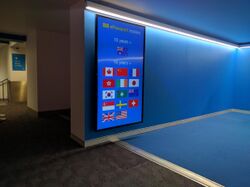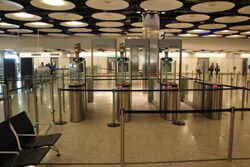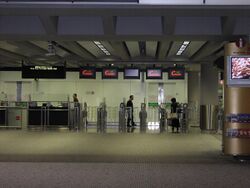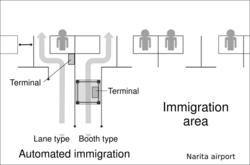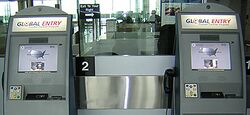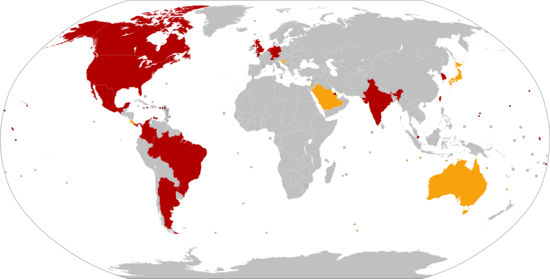Automated Border Control systems
 From HandWiki - Reading time: 24 min
From HandWiki - Reading time: 24 min
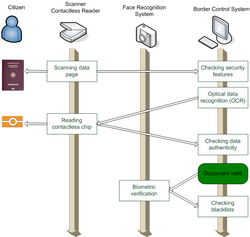
Automated Border Control systems (ABC) or eGates are automated self-service barriers which use the data stored in the chip in biometric passports to verify the user's identity. Travellers undergo biometric verification using face, fingerprint, iris recognition or a combination of modalities. After the identification process is complete, a physical barrier such as a gate or turnstile opens to permit passage. E-gates came about in the mid-2000s as an automated method of reading the newly ICAO mandated e-passports.
The number of e-Gate units deployed globally is expected to triple from 1,100 in 2013 to more than 3,200 in 2018, according to a 2014 report by Acuity Market Intelligence. Most e-gates have been deployed in airports in Europe, Australia and Asia.[2]
Privacy issues
Automated Border Control systems typically collect personal information such as the information on the biometric page of the passport: name, gender, date of birth, passport number, passport photograph, nationality, and the country of origin of the passport.[3]
Other information may also be collected, such as travel details, and the facial biometric template.[3]
Travellers passport booklets are typically no longer stamped if they are processed by eGates.
Australia
SmartGate is an automated self-service border control system operated by the Australian Border Force and located at immigration checkpoints in arrival halls in eight Australian international airports. SmartGates allow Australian ePassport holders and ePassport holders of a number of other countries to clear immigration controls more rapidly, and to enhance travel security by performing passport control checks electronically.[4] SmartGate uses facial recognition technology to verify the traveller's identity against the data stored in the chip in their biometric passport, as well as checking against immigration databases.
Travellers require a biometric passport to use SmartGate as it uses information from the passport (such as photograph, name and date of birth) and in the respective countries' databases (i.e. banned travellers database) to decide whether to grant entry or departure from Australia or to generate a referral to a customs agent.[5] These checks would otherwise require manual processing by a human which is time-consuming, costly and potentially error-prone.[6]
Eligibility
Travellers are required to hold an ePassport, a valid Australian visa (except for Australian citizens) and complete an arrival card. The system requires travellers to look as much like their passport photo as possible, which may require removing glasses or hats when using SmartGate.
Requirements
Departing travellers, regardless of age and nationality, can use SmartGate if they have a machine-readable passport and can independently use the machine.
Arriving travellers using SmartGate must comply with more stringent conditions:[3]
- hold a valid and current biometric passport
- are over the age of 16 (over the age of 10, if an Australian passport holder and accompanied by at least two adults)
- hold an ePassport issued by one of the following jurisdictions:
|
Exceptions
There are a number of notable exceptions when entering and departing Australia and using SmartGate.[3]
- If airline crew meet the above requirements they are also eligible to use SmartGate or they may continue to use the "crew lane".[3]
- Australian and New Zealand citizens travelling on military orders may not use SmartGate upon arrival.[3]
- Australian children aged 10 to 15 years (inclusive) can use SmartGate upon arrival if they are accompanied by at least two adults.[3]
Locations
In Australia, SmartGate is available at nine international airports: Adelaide, Brisbane, Cairns, Canberra, Darwin, Gold Coast, Melbourne, Perth and Sydney
History
The first trials of SmartGate began in 2002 with Qantas aircrews.[8] The trials were expanded in 2004 to include over 1,000 Qantas platinum frequent flyers, and in 2007 it was launched to the public at Brisbane Airport.[4]
Since October 2005, Australia has issued only biometric passports, called ePassports. As the validity of Australian passports do not exceed 10 years, all previous Australian passports have now expired and are now biometric.
In May 2015, the Australian Government announced that SmartGate will be launched at air and sea ports, using solely biometrics to identify and process arriving passengers, with a goal of processing 90% of air travellers automatically by 2020. The introduction of biometric arrivals, under the Seamless Traveller initiative, is expected to cost approximately AUD93.7m over 5 years and be completed by March 2019.
Canada
The Canadian Passenger Accelerated Service System (CANPASS) is a suite of Canada Border Services Agency programs in place to streamline customs and immigration clearance for pre-screened, low-risk, frequent travellers. Canadian and US citizens and permanent residents are eligible.[9]
CANPASS Air has been discontinued as of 3 April 2018. Current members can continue using their benefits until their card expires, at which point the CBSA encourages them to join NEXUS.
CANPASS still exists for private and corporate aircraft owners, and enables expedited customs clearance upon return to Canada.
European Economic Area
The European Union funded project FastPass, one of the Seventh Framework Programmes (FP7), aims to develop and demonstrate a harmonized, modular reference system for European automated border crossing points.[10] Another FP7 project is the ABC4EU project, the primary aim of which is to make border control more flexible by enhancing the workflow and harmonizing the functionalities of ABC e-gates.[11]
Most ABC systems in member states of the European Economic Area (EEA) (which includes all the member states of the European Union together with the EFTA states of Iceland, Liechtenstein and Norway ) and in Switzerland are available for citizens of the EEA and Switzerland to use since, according to Council Regulation (EC) No 2252/2004, all passports and travel documents issued by EFTA and EU member states shall comply with minimum security standards, and passports must incorporate a storage medium (a chip) that contains the holder's facial image and fingerprints.[12]
It was planned that, except for Denmark, Ireland and the UK, EU passports would have digital imaging and fingerprint scan biometrics placed on their RFID chips.[13] This combination of biometrics aims to create an unrivalled level of security and protection against fraudulent identification papers. Technical specifications for the new passports have been established by the European Commission.[14] The specifications are binding for the Schengen agreement parties, i.e. the EU countries, except Ireland and the UK, and three of the four European Free Trade Association countries – Iceland, Norway and Switzerland.[15] These countries were obliged to implement machine readable facial images in the passports by 28 August 2006, and fingerprints by 29 June 2009.[citation needed] According to EU requirements, only nations that are signatories to the Schengen acquis are required to add fingerprint biometrics.[16]
Belgium
Passengers who are over 12 years old and have an electronic EU passport can make use of the automated border control gates if they travel to a destination outside the Schengen area.[17]
ABC gates are available at the following locations:
- Brussels Airport
Czech Republic
Easy Go enables self-service passport clearance for flights.
Citizens of the European Economic Area and Switzerland, who are biometric passport holders and over 15, can use Easy Go.
Prague Airport is the first airport in Central and Eastern Europe to offer its passengers an automatic passport control at the E-Gate. It can be used by passengers arriving in Terminal 1[18] and is based on the German EasyPASS border control system
Denmark
Copenhagen Airport has installed self-service passport control at the beginning of Pier C.
The automated passport control e-gates can be used by European Economic Area or Swiss citizens aged 18 or over.[19]
Finland
The automated border control system is operated by the Finnish Border Guard and is based on the biometric identification of passengers. A real-life picture is taken to compare individual facial dimensions with the photograph held on the chip in the passport. Passengers travelling with an infant or with a wheelchair still need to choose the manual border control line.
The Finnish Border Guard will implement automated border checks for all nationalities.
Helsinki Airport has dozens of automated passport machines. These can be used by travellers who have an e-passport (biometric passport).
- Citizens of EU, EEA, Switzerland and Japan can use the passport machines at arrival and departure.
- Citizens of South Korea, the US, Canada, Australia and New Zealand can use the passport machines whenever they are departing.
France
Parafe gates are operated by the direction centrale de la police aux frontières and located at immigration checkpoints in arrival halls in Paris and Marseille airports, offering an alternative to using desks staffed by immigration officers. The gates use fingerprint technology to verify the user's identity against the data stored in the chip in travellers' biometric passports.
French citizens, European Economic Area and Swiss citizens can use the Parafe gates, provided that they are aged either 18 and over and holding valid and registered biometric passports. French passport holders are pre-registered.[20] While the online documentation has not been updated, at least some other European passports work without preregistration. It is known that German passports work without preregistration. German passports, like French passports (but unlike UK passports), have fingerprint information encrypted on the passport chip. Other EEA/Swiss passports with fingerprint information encrypted on the passport chip might work as well.
Parafe gates are available at the following locations:
- Paris Orly
- Charles de Gaulle Airport
- Lyon Airport
- Marseille Provence Airport
- Nice Côte d'Azur Airport
- Eurostar St Pancras Terminal
Germany
EasyPASS border control system - This is available for passengers over 18 (at most airports) with European EPassports. Additionally, USA, South Korea and Hong Kong Passport holders can register to use the system. EasyPASS is available at:
- Berlin Schönefeld Airport
- Berlin Tegel Airport
- Cologne/Bonn Airport
- Düsseldorf Airport
- Frankfurt Airport - Passengers aged 16+ can use the gates
- Hamburg Airport
- Munich Airport - Passengers aged 12+ can use the gates.
Hungary
An EPassport Gate is available at each Passport Control at Budapest Airport. The system involves visiting a kiosk for a passport, facial and finger scan, then proceeding to the gate for another finger scan. The system is open to passengers over 18 with European EPassports.
Ireland
The Irish Naturalisation and Immigration Service operates eGates at Dublin Airport for arrivals at Terminal 1 (Piers 1 and 2) and Terminal 2. They are currently available to citizens of Switzerland and the European Economic Area with electronic passports aged 18 or over. There are proposals to extend the service to non-European citizens. Irish Passport Cards can not be used.
Italy
ePassport gates are operated by the Polizia di Frontiera and located at selected immigration checkpoints in non-Schengen arrival and departure halls in some airports across Italy, offering an alternative to using desks staffed by immigration officers. The gates use facial recognition technology to verify the user's identity against the data stored in the chip in their biometric passport.
The system can be used by European Economic Area and Swiss citizens aged 14 and over.
At Rome and Venice airports (and at Milan-Malpensa soon), eGates are also available to Australian, Canadian, Japanese, New Zealand, South Korean and US biometric passport holders (however these citizens, after a successful eGate crossing, will still be referred to a border force agent that makes the final entry decision and stamps the passport)[21]
eGates are available at the following locations:
- Naples Airport[22]
- Rome Fiumicino Airport[23]
- Rome Ciampino Airport[24]
- Bologna Guglielmo Marconi Airport[25]
- Venice Marco Polo Airport[26]
- Milan Malpensa Airport
- Treviso Airport[27]
In the near future, eGates will be available in Milan-Linate, Verona, Pisa and Florence airport.[28]
Luxembourg
In 2017, five ABC gates were installed in the departure Passport Control and another five in the arrival Passport Control. Passengers who are over 18 with European EPassports may use the ABC gates.
Norway
The EasyPass system was introduced in 2012. Two automated self-service passport control units was put in place, designed in collaboration with the National Police Directorate.
Oslo Airport was the first in Norway to implement self-service passport control. Initially only Norwegian passport holders were eligible.[29] In the fall of 2017, eight new e-gates were installed for departing passengers, and during 2017, twelve were installed on arrival.[30]
Norwegian and European Economic Area citizens can use ePassport gates, provided that they are aged either 18 and over and holding valid biometric passports.[31]
Portugal
EGates are available at Lisbon Airport Terminal 1 and Faro Airport. They can be used by citizens with European EPassports who are 18 years old and over.
Spain
At some Spanish borders, Automated Border Control (ABC) is available to European citizens over 18 with EPassports at immigration halls. They come in either a gate, kiosk and gate, or mantrap kiosk configuration.
In the gate configuration, a passenger places their passport on a reader, looks at a camera and walks through a set of barriers. Finger scans are sometimes taken depending on the type of gate.
In the kiosk and gate configuration, a passenger approaches a kiosk for a facial, finger and passport scan. They then proceed to a set of doors and pass through using their fingerprint.
In the mantrap kiosk configuration, a passenger walks through a first set of barriers to a kiosk for a facial, finger and passport scan. They then proceed out through a second set of barriers.
Automated Border Control is available at the following:
- Port of Algeciras - Kiosk and gate configuration
- Alicante Airport - Mantrap kiosk configuration
- Barcelona Airport - Mantrap Kiosk configuration at Terminal 1 and kiosk and gate configuration at Terminal 2
- Girona Airport - Kiosk and gate configuration
- La Linea de la Concepción - Gate configuration
- Madrid Airport - Kiosk and gate configuration at Terminal 1 and mantrap kiosk configuration at Terminal 4S
- Malaga Airport - Kiosk and gate configuration
- Palma de Mallorca Airport - Gate configuration - ABC gates are also available at the departure passport control hall.
- Tenerife South Airport - Kiosk and Gate configuration
United Kingdom
ePassport gates are operated by the UK Border Force and located at immigration checkpoints in arrival halls in some airports across the United Kingdom, offering an alternative to using desks staffed by immigration officers. The gates use facial recognition technology to verify the user's identity against the data stored in the chip in their biometric passport.
British citizens, European Economic Area citizens and citizens of Australia, Canada, Hong Kong, Japan, New Zealand, Singapore, South Korea , Taiwan and the United States who are enrolled in the Registered Traveller Service,[32] can use ePassport gates, provided that they are aged either 18 and over or 12 and over travelling with an adult and holding valid biometric passports.
ePassport gates are available at the following locations:
- Birmingham Airport
- Bristol Airport
- Cardiff Airport
- East Midlands Airport
- Edinburgh Airport
- Eurostar St Pancras Terminal
- Eurostar Brussels-Zuid Terminal
- Gatwick Airport (North and South Terminals)
- Glasgow Airport
- Heathrow Airport (Terminals 2, 3, 4 and 5)†
- London City Airport
- Luton Airport
- Manchester Airport (Terminals 1, 2 and 3)
- Newcastle Airport
- Stansted Airport
† Heathrow Airport Terminal 1 became obsolete on 29 June 2015.
Hong Kong
Hong Kong's e-Channels are situated at all border crossing points. A person who holds a Hong Kong Identity Card (HKID) inserts the card into a slot to enter the first eGate and then has their thumbprint scanned to pass through the second eGate.[33]
The Automated Passenger Clearance System was introduced by the Hong Kong Immigration Department in 2004 and designed to speed up border immigration processes for residents of Hong Kong, Macau and frequent visitors to Hong Kong entering and exiting the territory whether it be by land, air or sea via the use of self-service kiosks employed at various border control points.[34]
Eligibility
- A Hong Kong permanent resident aged 11 or above[35] (using a smart identity card)
- A Hong Kong resident aged 11 or above holding a Document of Identity for Visa Purposes (using a smart identity card and carrying a valid Document of Identity for Visa Purposes)
- A person aged 11 or above who has the right to land or is on unconditional stay in Hong Kong (using a smart identity card)
- A non-permanent resident issued with a notification label (using a smart identity card and carrying a valid travel document)
- A registered cross-boundary primary school student under the age of 11 (using the enrolled valid travel document)
- A registered frequent visitor aged 18 or above (using the enrolled valid travel document)
- A registered Macau permanent resident aged 11 or above (using a Macau permanent identity card)
- A registered Republic of Korea citizen aged 17 or above and enrolled under Smart Entry Service (SES) scheme[36] (using the Republic of Korea Passport valid for at least 6 months and having no adverse record in the HKSAR)
- An enrolled holder of a Republic of Singapore Passport aged 11 or above[37] (using a Republic of Singapore Passport valid for at least 6 months, completed 3 trips in past 12 months and having no adverse record in the HKSAR)
- An enrolled holder of a Federal Republic of Germany Passport aged 18 or above[38] (using a Federal Republic of Germany Passport valid for at least 6 months and having no adverse record in the HKSAR)
- An enrolled holder of an Australian Passport aged 16 or above[39] (using an Australian Passport valid for at least 6 months and having no adverse record in the HKSAR)
The user upon entrance to the e-Channel inserts his Hong Kong Identity Card into the card reader (which reads the embedded chip) or places his registered travel document or Macau Identity Card onto the document reader. The channel gate will open, the user takes his resident card and steps in and the gate will close. Thumb or finger is then placed onto the fingerprint reader, once identity has been confirmed, another set of gates in front open allowing exit. If an issue arises and identity cannot be confirmed or a malfunction occurs, an immigration supervisor will be on hand to assist.
Locations
First made available on 16 December 2004 in Lo Wu Control Point, over the past several years the locations have expanded to include:[35]
- Hong Kong International Airport (T1 & T2)
- Lo Wu
- Hung Hom
- Lok Ma Chau Spur Line
- Lok Ma Chau
- Man Kam To
- Sha Tau Kok
- Shenzhen Bay
- Hong Kong China Ferry Terminal
- Hong Kong-Macau Ferry Terminal
- Kai Tak Cruise Terminal
- Tuen Mun Ferry Terminal
By allowing registered users to use the self-service kiosks to pass through Hong Kong immigration, processing time averages around 12 seconds[34] making E-channels far more efficient than traditional immigration counters.
Macau
Since its first inception where only Right to Abode Hong Kong Permanent Identity Card holders were permitted to use the self-service kiosks, the program expanded on 12 September 2006; allowing not only those of Right to Land or those with unconditional stay in Hong Kong but also to those residents and non-residents with notification labels to use the E-Channels.
The program was expanded further again on 10 December 2009 to allow holders of Macau Resident Identity Card to register for and use of the Hong Kong E-channels to enter and exit the territory.
Border cities to Hong Kong on Mainland China's side such as Shenzhen have E-Channels for use of the Home Return Permit cards.
Frequent Visitor Automated Passenger Clearance
Frequent visitors to Hong Kong as well as Macau Resident Card holders can register for Frequent Visitor Automated Passenger Clearance.
A valid travel document with a multiple visit visa (if applicable), plus one of the following documents is needed:
- A valid HKSAR Travel Pass or
- An APEC Business Travel Card with the economy code ‘HKG’ or
- Hong Kong International Airport Frequent Visitor Card or
- Frequent Flyer Programme Membership Card issued by an airline which has joined this arrangement (please enquire with your airline).
e-Channel Service for foreign nationals
The Frequent Visitor program was further expanded to nationals of the following countries. Such arrangements are reciprocal and eligible HKSAR passport holders may also enrol for the respective automated border clearance schemes under these countries:
- Republic of Korea enrolled under Smart Entry Service (SES) scheme (Since 16 December 2013)
- Singapore (Since 22 September 2014)
- Germany (Since 1 November 2014)
- Australia (Since 20 June 2016)
One Stop Customs and Immigration clearance
A special vehicular E-Channel has been erected for Shenzhen Bay known as One Stop Customs and Immigration Clearance for goods vehicle passing through the Shenzhen Bay Control Point, indicating how versatile this system is, and an asset for the Hong Kong Immigration Department[clarification needed].
Japan
Japan 's J-BIS Biounit is an immigration control system that was introduced into Japanese airports and located at immigration booths. Fingerprints of both index fingers are collected along with a photograph. At the same time, the person is checked against immigration office lists, and criminals, people who were previously deported, and other punished foreigners are prevented from entering Japan. On 20 November 2007, Narita Airport, Kansai International Airport,[40] and Chūbu Centrair International Airport had the system, with plans to roll out the system to the 27 airports and 126 harbours in Japan.[41]
Until the start of J-BIS, when people would land in Japan and apply for entry, it was difficult to tell which people had changed their names or used special names on their passports, had been deported, or had criminal records. After the events of 9/11, Japan amended its Immigration Control and Refugee Recognition Act.
On 20 November 2007, the changes to the act went into effect. Most foreigners (everyone except special permanent residents, diplomats, people who were invited by the government, and people under the age of 16) were now required to have fingerprints taken from their two index fingers, as well as a photograph. The J-BIS system was the second system of its type enacted in the world; the first was the United States's US-VISIT system.[42]
The fingerprint scans and photographs are transferred from the airport to the immigration office's servers, and this information is compared against a blacklist in around five seconds.
This list is a collection of Interpol information and around 14,000 people that have been searched by Japanese police, as well as the fingerprints and pictures that were recorded from around 800,000 foreigners who were deported from Japan.[42] According to the immigration office, it is predicted that 0.001% of people who enter Japan appear on the blacklist.[42]
Since the introduction of the system, 846 people received exclusion orders by immigration authorities[43] and 8 people were arrested for fabricating their fingerprints.[44] The Japan Coast Guard also reported that the number of smugglers crossing the Korea Strait from the Korean peninsula has increased rapidly.[43]
Along with the introduction of J-BIS, an "Automated gate" (自動化ゲート) was set up at Terminal 1 and 2 at Narita Airport, Haneda Airport, Chubu Centrair Airport and Kansai Airport.[45] With this system, when a person enters or leaves Japan, rather than having to be processed by a human examiner there, a person can use an eGate, thereby making both entry and departure simpler and easier, as well as more convenient.[46] Japanese people with valid passports, foreigners with both valid passports (this includes refugees with valid travel certificates and re-entry permits) and re-entry permits can use this system.[46]
The gate works by holding up the identification page of the passport up to the terminal in front of the transparent booth, and the entrance to the booth will open. Inside the booth, there is an equipment to read fingerprints, where prints from two fingers are taken. After confirmation of identity, the exit gate will open.[46] Although there is a worker sitting at the gate, according to the Ministry of Justice immigration office's information guide to the automated gates, most Japanese should be able to use the automated gate.[46] When the automated gate is used, passports are not stamped. When an entry stamp is needed, officials are available near the gate to stamp passports;[47] alternatively, one can use the regular gate.
To use Japanese eGgates, prior registration is required. For details, see the Ministry of Justice immigration office's information guide. For this advance registration, Japanese people (those who hold Japanese passports), only fingerprints are needed (not an image), as the automated gate does not take a picture.
Korea
Korea's Smart Entry Service (SeS) is a voluntary program that allows pre-approved and trusted travellers to proceed through Korean immigration using biometric information included in their passports at eGates. Typically this takes less than 12 seconds.[48]
Eligible applicants register their fingerprints and facial image in advance and must agree to the use of their registered personal information.
South Koreans aged 7 or above, citizens from selected countries, foreigners aged 17 or above and holding Korean Alien Registration Card, foreign crew members with multiple-entry visas, and foreigners holding Korea Priority Card issued by Ministry of Justice are eligible. Foreign nationalities eligible to register include American citizens enrolled in Global Entry, Hong Kong SAR passport holders, Macau SAR passport holders, and Taiwanese passport holders. The nationals must not hold Korean Alien Registration Card. For Hong Kong, Macau, and Taiwan passport holders, they must not use other passports such as People's Republic of China passport, British National (Overseas) passport, and Portuguese passport when they enter Korea to be eligible.
Macau
Macau uses the same E-Channel system as Hong Kong. Hong Kong ID Card holders can register. Border cities to Macau on Mainland China's side such as Zhuhai have E-Channels to use Home Return Permit cards.
Mexico
Mexico's Viajero Confiable program is only open to Mexican and US citizens who are members of Global Entry. It is a Western Hemisphere Travel Initiative (WHTI) program and prospective members must pass a background check, interview with a Mexican immigration officer, and have fingerprints and iris scans taken. Kiosks are currently available at the Cancun, Los Cabos, and Mexico City international airports, but the Mexican government hopes to expand it to other cities in the near future.[49]
New Zealand
New Zealand also operates the Australian manufactured SmartGate system at Auckland, Wellington, Christchurch and Queenstown airports,[50] but with a more limited list of eligible passports than in Australia: only ePassports issued by New Zealand, Australia, Canada, China, France, Germany, Ireland and the Netherlands, the United Kingdom, and the United States can be used.
eGates can only be used by travellers 12 years of age or older. (Customs is conducting a trial, in conjunction with other border agencies, about whether to lower the age of eligibility to use eGate for people with an eligible ePassport from 12 years of age to 10 years of age.)
New Zealand eGates use biometrics to match the picture of your face in your ePassport with the picture it takes of you at the gate.
To make sure eGate can do this, travellers must make sure they look as similar to their ePassport photos as possible and remove veils, scarves and hats that obscures any part of the face. Glasses may be left in place if worn in the ePassport photo and they have thin frames. eGate can handle minor changes in your face, for example if the travellers' weight or hair has changed.
Customs, Biosecurity and Immigration officials will use information provided at eGates, including photos, to clear travellers and their items across New Zealand's border.
Biometric information is kept for three months before destruction but other information, including about movements across New Zealand's border is kept indefinitely and handled in accordance with the Privacy Act 1993, or as the law authorises. This might include information being used by or shared with other law enforcement or border control authorities.
Singapore
The Immigration and Checkpoints Authority of Singapore (ICA) has integrated information technology to streamline the entry and exit procedure at checkpoints. Singapore citizens, permanent residents and other registered travellers can use automated lanes called enhanced-Immigration Automated Clearance System (eIACS). The Biometric Identification of Motorbikers (BIKES) System at ICA's land checkpoints can be used by residents and work pass holders entering and leaving Singapore by motorcycle.
In 2016, ICA began the biometric registering and verification of travellers using the Bioscreen system.[51] Singapore citizens and Permanent Residents have their iris bio-data registered as well.[52]
Taiwan
Taiwan's eGate is a free automated entry system for Taiwanese citizens and certain classes of residents and frequent visitors. Users simply scan their travel documents at the gate and are passed through for facial recognition. Electronic fingerprinting is used when facial recognition fails. Registration is available at the immigration counter right at the port of entry.[53]
Thailand
Thailand's automated passport control (APC) system at Suvarnabhumi Airport has been available for Thai nationals since 2012.[54] Since 2017 even Singaporeans can use the Automated Gate.[55]
USA
Global Entry is a program of the U.S. Customs and Border Protection service that allows pre-approved, low-risk travellers to receive expedited clearance upon arrival into the United States .
Sometimes travellers approved for Global Entry can use eGates called kiosks at US locations.
As of October 2017, the program was available at 54 US airports and 15 pre-clearance locations.[56] More than 1.8 million people are enrolled in Global Entry and approximately 50,000 new applications for the program are filed monthly.[57]
Enrolment
To enrol in Global Entry, applicants must first file an application with US Customs and Border Protection, and then submit to an interview and background check. The wait for an interview may be months.[58] There is a USD100 non-refundable fee for the application, even for infants and children (some credit cards reimburse this fee).[59] During the interview, the applicant's fingerprints are captured and a digital photo is taken. Applicants are also given instructions on how to use the automated kiosk. Once an application is approved, the applicant may use the Global Entry kiosk at any participating airport for a duration of five years past one's next birthday following approval. Renewal requires an additional fee.[60]
Enrolment eligibility
Countries currently participating in Global Entry include the following:[61]
 Argentina[62]
Argentina[62] Canada
Canada Colombia
Colombia Germany [57]
Germany [57] India[63]
India[63] Mexico
Mexico Netherlands (no new applications possible,[64] new program in progress, but no ETA available)
Netherlands (no new applications possible,[64] new program in progress, but no ETA available) Panama
Panama Singapore[65]
Singapore[65] South Korea
South Korea Switzerland[66]
Switzerland[66]- Template:ROC-TWN[56]
 United Kingdom[67]
United Kingdom[67] United States (US citizens and lawful permanent residents)
United States (US citizens and lawful permanent residents)
Entry procedure
Enrolled users must present their machine-readable passport or permanent residency card, and submit their fingerprints to establish identity. Users then complete a computerized customs declaration, and are issued a receipt instructing them to either proceed to baggage claim, or to a normal inspection booth for an interview.[68]
Participants may enter the United States (or the United States pre-clearance area in select international airports) by utilizing automated kiosks located at the following airports:[69]
- Abu Dhabi International Airport (AUH)*
- Anchorage – Ted Stevens Anchorage International Airport (ANC)
- Atlanta – Hartsfield-Jackson Atlanta International Airport (ATL)
- Austin-Bergstrom International Airport (AUS)
- Baltimore/Washington International Thurgood Marshall Airport (BWI)
- Boston – Logan International Airport (BOS)
- Burlington International Airport (BTV)*
- Calgary International Airport (YYC)
- Charlotte-Douglas International Airport (CLT)
- Chicago Midway International Airport (MDW)*
- Chicago O'Hare International Airport (ORD)
- Cincinnati/Northern Kentucky International Airport (CVG)
- Cleveland Hopkins International Airport (CLE)
- Dallas/Fort Worth International Airport (DFW)
- Daniel K. Inouye International Airport (HNL)
- Denver International Airport (DEN)
- Detroit Metropolitan Airport (DTW)
- Dublin Airport (DUB)*
- Edmonton International Airport (YEG)
- Fairbanks International Airport (FAI)
- Fort Lauderdale/Hollywood International Airport (FLL)
- General Mitchell International Airport, Milwaukee (MKE)
- Guam International Airport (GUM)
- Halifax Stanfield International Airport (YHZ)
- Houston George Bush Intercontinental Airport (IAH)
- John F. Kennedy International Airport, New York City (JFK)
- John Wayne Airport (SNA)*
- Lambert-St. Louis International Airport (STL)
- Los Angeles International Airport (LAX)
- McCarran International Airport, Las Vegas (LAS)
- Miami International Airport (MIA)
- Minneapolis/St. Paul International Airport (MSP)
- Montréal–Pierre Elliott Trudeau International Airport (YUL)
- Newark Liberty International Airport (EWR)
- Oakland International Airport (OAK)*
- Orlando International Airport (MCO)
- Orlando-Sanford International Airport (SFB)
- Ottawa Macdonald-Cartier International Airport (YOW)
- Philadelphia International Airport (PHL)
- Phoenix Sky Harbor International Airport (PHX)
- Pittsburgh International Airport (PIT)
- Portland International Airport (PDX)
- Queen Beatrix International Airport, Aruba (AUA)*
- Raleigh-Durham International Airport (RDU)*
- Saipan International Airport (SPN)*
- Salt Lake City International Airport (SLC)
- San Antonio International Airport (SAT)
- San Diego International Airport (SAN)
- San Francisco International Airport (SFO)
- San Jose International Airport (SJC)*
- San Juan Luis Muñoz Marin International Airport (SJU)
- Seattle-Tacoma International Airport – SeaTac (SEA)
- Shannon Airport (SNN)*
- Lynden Pindling International Airport, Bahamas (NAS)*
- Tampa International Airport (TPA)
- Toronto Pearson International Airport (YYZ)
- Vancouver International Airport (YVR)
- Washington-Dulles International Airport (IAD)
- Winnipeg James Armstrong Richardson International Airport (YWG)
The * indicates there are no enrolment centres at these sites.
Disqualification and revocation
Any type of criminal conviction may disqualify eligibility for the Global Entry program. Three to five percent of those who sign up for the program are rejected; in such cases, they are generally told the reason for the rejection. For example, paying a fine for having a prohibited or undeclared item at a US port of entry generally will ensure disqualification.
Those whose Global Entry applications are denied have three ways to appeal: making an appointment to speak with a supervisor at a "trusted traveler enrollment center", e-mailing the Trusted Traveler Ombudsman, or filing a complaint through the Department of Homeland Security's "Traveler Redress Inquiry Program".[70]
CBP claims that in less than one percent of cases in which Global Entry was granted, it will be revoked. In these situations, an explanation for the revocation is not necessarily supplied.[71]
History
During the 1990s and early 2000s, the US Immigration and Naturalization Service operated INSPASS, a trusted traveller program designed to integrate with Canadian and European programs, at JFK and Newark Airports. INSPASS operated with a similar system, identifying travellers with their handprint. The program was discontinued in 2002 when the INS was merged with US Customs to form US Customs and Border Protection.[72]
The Global Entry program was initially deployed at a small number of airports, including New York-JFK (Terminal 4), Washington-Dulles and Houston-Intercontinental. Following a good reception by travellers, the program was expanded to include Los Angeles International, Atlanta-Hartsfield, Chicago-O'Hare and Miami International Airport.
In May 2009, Global Entry membership was expanded to include Netherlands citizens who were also members of the Dutch Privium trusted traveller program under the FLUX (Fast Low-risk Universal Crossing) alliance. Present members of Global Entry are now permitted to apply to join the Privium program at Amsterdam-Schiphol International Airport allowing entry into the Schengen area. Members of NEXUS and SENTRI are also entitled to use Global Entry.[59]
See also
- Iris Recognition Immigration System
- Port Passenger Accelerated Service System (PORTPASS)
- Secure Electronic Network for Travelers Rapid Inspection (SENTRI)
- Airport of Entry
- Port of entry
References
- ↑ Funke, Holger. "Automatic Border Control Systems (eGate)". blog.protocolbench.org. https://blog.protocolbench.org/2013/08/automatic-border-control-systems-egate.
- ↑ "E-Gates ease and secure international travel - SecureIDNews" (in en-US). SecureIDNews. https://www.secureidnews.com/news-item/e-gates-ease-and-secure-international-travel/.
- ↑ 3.0 3.1 3.2 3.3 3.4 3.5 3.6 "Arrivals SmartGate". https://www.border.gov.au/Trav/Ente/Goin/Arrival/Smartgateor-ePassport.
- ↑ 4.0 4.1 "New SmartGate aims to decrease airport queues". http://www.newshub.co.nz/home/new-zealand/2015/07/new-smartgate-aims-to-decrease-airport-queues.html.
- ↑ "New Zealand Customs Service : How does SmartGate work?". http://www.customs.govt.nz/features/smartgate/howsmartgateworks/Pages/default.aspx.
- ↑ "Part 5: Processing passengers faster at airports — Office of the Auditor-General New Zealand" (in en). http://www.oag.govt.nz/2012/realising-benefits/part5.htm.
- ↑ "UAE nationals can use SmartGate at Australian airports". http://www.arabianbusiness.com/content/376942-uae-nationals-can-use-smartgate-at-australian-airports. Retrieved 31 March 2018.
- ↑ "Roger Clarke's 'SmartGate'". http://www.rogerclarke.com/DV/SmartGate.html.
- ↑ CANPASS: Streamlines customs clearance for frequent travellers www.cbsa-asfc.gc.ca/canpass
- ↑ "FastPass - EU project on e-gates for passenger transport | ENAT" (in en). http://www.accessibletourism.org/?i=enat.en.enat_projects_and_good_practices.1803.
- ↑ "Automated border control e-gates and facial recognition systems" (in en). Computers & Security 62: 49–72. 2016-09-01. doi:10.1016/j.cose.2016.07.001. ISSN 0167-4048. https://www.sciencedirect.com/science/article/pii/S0167404816300736.
- ↑ "Council Regulation (EC) No 2252/2004 on standards for security features and biometrics in passports and travel documents issued by Member States". http://eur-lex.europa.eu/LexUriServ/LexUriServ.do?uri=CELEX:32004R2252:EN:HTML.
- ↑ Jonathan P. Aus (25 September 2006). "Decision-making under Pressure: The Negotiation of the Biometric Passports Regulation in the Council" (in no). Arena.uio.no. http://www.arena.uio.no/publications/working-papers2006/papers/wp06_11.xml. Retrieved 8 September 2010.
- ↑ EC News article about the relevant regulations: Council Regulation (EC) 2252/2004, Commission Decision C(2005)409 adopted on 28 February 2005 and Commission Decision C(2006)2909 adopted on 28 June 2006
- ↑ Council Regulation (EC) No 2252/2004 of 13 December 2004, see preamble 10–14
- ↑ COUNCIL REGULATION (EC) No 2252/2004 of 13 December 2004 on standards for security features and biometrics in passports and travel documents issued by Member States. Official Journal of the European Union. 29 December 2004. http://eur-lex.europa.eu/LexUriServ/site/en/oj/2004/l_385/l_38520041229en00010006.pdf. Retrieved 6 October 2010.
- ↑ "Border control" (in en-BE). Brussels Airport Website. https://www.brusselsairport.be/en/passngr/at-the-airport/border-control.
- ↑ info@lundegaard.cz, Lundegaard - e-business solutions provider, www.lundegaard.cz,. "Prague Airport's first E-Gate | Vaclav Havel Airport Prague, Ruzyne" (in en). http://www.prg.aero/en/news/news/prague-airports-first-e-gate/.
- ↑ "Selvbetjent paskontrol" (in da). https://www.cph.dk/praktisk/pas-og-paskontrol/selvbetjent-paskontrol/.
- ↑ l'Intérieur, Ministère de. "Le passage rapide aux frontières extérieures PARAFE" (in fr-FR). https://www.immigration.interieur.gouv.fr/Europe-et-International/La-circulation-transfrontiere/Le-passage-rapide-aux-frontieres-exterieures-PARAFE.
- ↑ "E-Gates with Canadian (and other non-EU) biometric passports". https://m.veniceairport.it/en/news/101/canadian-with-biometric-passport-e-gates.html.
- ↑ "Naples introduces ABC eGates for EU passengers". http://www.passengerselfservice.com/2016/01/naples-introduces-abc-egates-for-eu-passengers/.
- ↑ "Aeroporti di Roma - E-gates". http://www.adr.it/web/aeroporti-di-roma-en-/e-gates.
- ↑ "Aeroporti di Roma - E-gates". http://www.adr.it/web/aeroporti-di-roma-en-/e-gates.
- ↑ "Bologna Airport gets ABC e-Gates". http://www.passengerselfservice.com/2017/02/bologna-airport-gets-abc-e-gates/.
- ↑ "CHECKS AND SECURITY Security rules, regulations and procedures at Venice Marco Polo Airport". http://www.veniceairport.it/en/at-the-airport/checks-and-security.html.
- ↑ "EUROPEAN AND SWISS WITH BIOMETRIC PASSPORT E-GATES". https://www.trevisoairport.it/en/news/102/european-and-swiss-with-biometric-passport-e-gates.html.
- ↑ "Nel 2018 sette e-gates negli aeroporti toscani". https://www.teleborsa.it/News/2018/02/05/nel-2018-sette-e-gates-negli-aeroporti-toscani-131.html#.Wuzzwy9ab6Y.
- ↑ "Oslo Airport initiates self-service passport control" (in en-GB). Future Travel Experience. 2013-01-07. http://www.futuretravelexperience.com/2013/01/oslo-airport-initiates-self-service-passport-control/.
- ↑ "Sto du i denne enorme køen på Oslo Lufthavn i fjor? Nå skal køproblemene være over." (in nb-NO). Aftenposten. https://www.aftenposten.no/reise/Na-skiftes-passkontrollen-ut-pa-Oslo-Lufthavn-10103b.html.
- ↑ NRK. "Politiet: Automatisk passkontroll løser ikke problemene" (in nb-NO). NRK. https://www.nrk.no/norge/politiet_-automatisk-passkontroll-loser-ikke-problemene-1.13116489.
- ↑ https://www.gov.uk/registered-traveller
- ↑ "e-Channel". http://www.immd.gov.hk/eng/services/echannel_residents.html.
- ↑ 34.0 34.1 http://unpan1.un.org/intradoc/groups/public/documents/unpan/unpan027893.pdf
- ↑ 35.0 35.1 http://www.gov.hk/en/residents/immigration/control/echannel.htm
- ↑ http://www.gov.hk/en/nonresidents/visarequire/echannel/kor.htm
- ↑ http://www.gov.hk/en/nonresidents/visarequire/echannel/singapore.htm
- ↑ http://www.gov.hk/en/nonresidents/visarequire/echannel/germany.htm
- ↑ http://www.immd.gov.hk/hkt/services/echannel_visitors.html#australia
- ↑ 「指紋や顔でチェック 関空でバイオ入国審査実験」 産経ニュース 2007年11月12日
- ↑ 「中部でも入国外国人の指紋採取「当然」「懸念も」 中日新聞 2007年11月20日
- ↑ 42.0 42.1 42.2 「来日外国人『指紋・顔写真』義務」 読売新聞 2007年11月20日
- ↑ 43.0 43.1 韓国―九州・山口で密航急増…バイオ認証避け海路, Yomiuri Shimbun, January 9, 2010
- ↑ 入国審査、指紋細工で告発8人 1~10月、法務省集計 , 47 news, December 6, 2009
- ↑ 「成田空港、11/20より自動化ゲート導入」 H.I.S.海外出張ニュース
- ↑ 46.0 46.1 46.2 46.3 「自動化ゲートの運用について」 法務省入国管理局 2007年11月
- ↑ "Users' Guide to the Automated Gates (For Foreign Nationals)". pp. 4. http://www.moj.go.jp/NYUKAN/nyukan63-9.pdf. Retrieved 2008-08-24.
- ↑ "Smart Entry Service". http://www.ses.go.kr/ses/main_en.ses.
- ↑ "Viajero Confiable". http://www.viajeroconfiable.inm.gob.mx/index.php/location/.
- ↑ "Morpho Australasia completes eGate installation in New Zealand airport". Messe Frankfurt New Era Business Media Ltd.. 16 December 2016. https://www.asmag.com/showpost/21778.aspx. "Safran Identity & Security, through its subsidiary Morpho Australasia, has completed installing the next generation of eGates into Christchurch Airport.
This installation is part of national upgrade and innovation program for 51 new generation border processing eGates for the New Zealand Customs Service (NZ Customs). The rollout has seen new generation Safran Identity & Security's eGates installed in Auckland, Wellington, Queenstown and now Christchurch airport." - ↑ "Why are we introducing fingerprint checks at our land checkpoints?" (in en). https://www.gov.sg/factually/content/why-are-we-introducing-fingerprint-checks-at-our-land-checkpoints.
- ↑ "Authorities to collect iris scans from Singaporeans, PRs starting Jan 1" (in en-US). Channel NewsAsia. https://www.channelnewsasia.com/news/singapore/authorities-to-collect-iris-scans-from-singaporeans-prs-starting-7657104.
- ↑ "e-Gate". http://www.immigration.gov.tw/egate/.
- ↑ "Singaporeans test automated immigration at Suvarnabhumi". 19 Aug 2017. https://www.bangkokpost.com/news/general/1309287/suvarnabhumi-automating-immigration-lanes.
- ↑ "Singaporeans can use passport scanners at Thailand's Suvarnabhumi airport". 20 August 2017. https://www.channelnewsasia.com/news/asia/singaporeans-can-use-passport-scanners-at-thailand-s-9139338.
- ↑ 56.0 56.1 "Taiwan joins US Global Entry travel program". AIT. https://www.ait.org.tw/taiwan-joins-global-entry/.
- ↑ 57.0 57.1 "CBP Announces Reciprocal Arrangement with Germany for Trusted Traveler Programs". U.S. Customs and Border Protection. December 29, 2014. http://www.cbp.gov/newsroom/national-media-release/2014-12-29-000000/cbp-announces-reciprocal-arrangement-germany.
- ↑ Hamm, Catharine M. (May 29, 2013). "Almost a 'Trusted Traveler': Are the airport hassles behind her now?l". Los Angeles Times. http://articles.latimes.com/2013/may/29/news/la-trb-global-entry-reader-tips-20130528. Retrieved February 2, 2016.
- ↑ 59.0 59.1 "How to Apply for Global Entry". U.S. Customs and Border Protection. http://www.cbp.gov/travel/trusted-traveler-programs/global-entry/how-apply. Retrieved December 3, 2015.
- ↑ "Global Entry Frequently Asked Questions". http://www.globalentry.gov/faq.html#e1.
- ↑ "Eligibility for Global Entry". http://www.cbp.gov/travel/trusted-traveler-programs/global-entry/eligibility.
- ↑ "Paso a paso: cómo funciona el sistema Global Entry para ingresar a los Estados Unidos". http://www.lanacion.com.ar/1924740-paso-a-paso-como-funciona-el-sistema-global-entry-para-ingresar-a-los-estados-unidos.
- ↑ "Expedited entry into US for Indian travellers from now on - Times of India". http://timesofindia.indiatimes.com/india/expedited-entry-into-us-for-indian-travellers-from-now-on/articleshow/59336272.cms. Retrieved June 28, 2017.
- ↑ https://insideflyer.nl/registered-traveller-program-nederland-maakt-global-entry-toegankelijk/
- ↑ "Faster immigration clearance for eligible Singaporeans travelling to US". http://www.channelnewsasia.com/news/singapore/faster-immigration/2908082.html.
- ↑ "Global Entry Program: 10 steps to accessing the U.S. Global Entry Program". https://www.fedpol.admin.ch/fedpol/en/home/pass---identitaetskarte/global-entry.html.
- ↑ "CBP Announces the Expansion of Global Entry to UK Citizens". U.S. Customs and Border Protection. November 3, 2015. http://www.cbp.gov/newsroom/national-media-release/2015-11-03-000000/cbp-announces-expansion-global-entry-uk-citizens.
- ↑ "How to Use the Kiosk". Archived from the original on June 25, 2009. https://web.archive.org/web/20090625090904/http://www.cbp.gov/xp/cgov/travel/trusted_traveler/global_entry/global_entry_discription.xml.
- ↑ "Airports with Global Entry Kiosks". U.S. Customs and Border Protection. http://www.cbp.gov/travel/trusted-traveler-programs/global-entry/locations.
- ↑ Stellin, Stella (October 8, 2012). "Frustrating Hurdle at Customs". The New York Times. https://www.nytimes.com/2012/10/09/business/global-entry-applications-rejected-for-past-brushes-with-law.html.
- ↑ Kugel, Seth (April 24, 2014). "Global Entry and Company: Worth the Price?". The New York Times. https://www.nytimes.com/2014/04/24/travel/global-entry-and-company-worth-the-price.html.
- ↑ http://www.globalsecurity.org/security/systems/inspass.htm USPASS (formerly INSPASS)
External links
- Australian Border Force: SmartGate
- gov.uk: Use ePassport gates for fast entry into the UK
- US Automated Passport control
 KSF
KSF